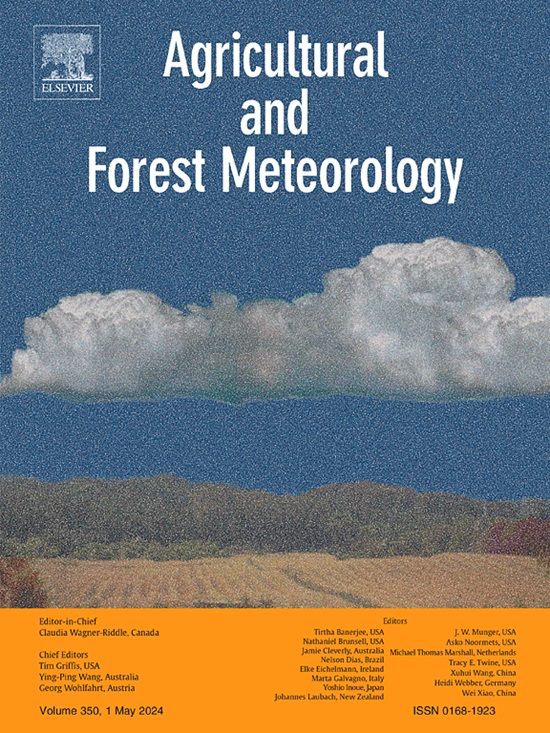Spatiotemporal heterogeneity of irrigation on heat waves across the North China plain
IF 5.7
1区 农林科学
Q1 AGRONOMY
引用次数: 0
Abstract
Irrigation affects the occurrence of heat waves globally, but its dynamics with local climate shifts and varying irrigation levels are not well understood. Utilizing observational data, spatiotemporal multivariate regression, and the window search algorithm, we delineate the effect of irrigation on heat waves in the North China Plain (NCP) before and after 1996. The results indicate that although the overall influence of irrigation is modest, contributing to a reduction of approximately 10 % in heat wave development, significant spatiotemporal heterogeneity is observed. Initially, irrigation mitigated northern and enhanced southern heat waves. Over time, the focus of mitigation expanded southwest, reducing the trend of heat wave frequency by 0.232 days/decade. We believe that local moisture conditions can explain these variations, which are visually represented through land-atmosphere coupling strength. Driven by climate mode shifts, overall aridity across the NCP has intensified, particularly in the southwest. The land-atmosphere coupling strength remains strong in the north but reverses in the southwest, leading to spatiotemporal heterogeneity of irrigation effects.


华北平原灌溉对热浪影响的时空异质性
灌溉影响全球热浪的发生,但其与局部气候变化和灌溉水平变化的动态关系尚不清楚。利用观测资料、时空多元回归和窗口搜索算法,研究了1996年前后灌溉对华北平原热浪的影响。结果表明,尽管灌溉对热浪发展的总体影响不大,减少了约10%,但存在显著的时空异质性。最初,灌溉缓解了北方的热浪,加剧了南方的热浪。随着时间的推移,缓解的重点向西南扩展,热浪频率的趋势减少了0.232 d / a。我们认为当地的湿度条件可以解释这些变化,这些变化可以通过陆-气耦合强度直观地表示出来。在气候模式转变的推动下,整个华北地区的总体干旱加剧,尤其是在西南部。陆地-大气耦合强度在北部保持较强,而在西南部则相反,导致灌溉效应的时空异质性。
本文章由计算机程序翻译,如有差异,请以英文原文为准。
求助全文
约1分钟内获得全文
求助全文
来源期刊
CiteScore
10.30
自引率
9.70%
发文量
415
审稿时长
69 days
期刊介绍:
Agricultural and Forest Meteorology is an international journal for the publication of original articles and reviews on the inter-relationship between meteorology, agriculture, forestry, and natural ecosystems. Emphasis is on basic and applied scientific research relevant to practical problems in the field of plant and soil sciences, ecology and biogeochemistry as affected by weather as well as climate variability and change. Theoretical models should be tested against experimental data. Articles must appeal to an international audience. Special issues devoted to single topics are also published.
Typical topics include canopy micrometeorology (e.g. canopy radiation transfer, turbulence near the ground, evapotranspiration, energy balance, fluxes of trace gases), micrometeorological instrumentation (e.g., sensors for trace gases, flux measurement instruments, radiation measurement techniques), aerobiology (e.g. the dispersion of pollen, spores, insects and pesticides), biometeorology (e.g. the effect of weather and climate on plant distribution, crop yield, water-use efficiency, and plant phenology), forest-fire/weather interactions, and feedbacks from vegetation to weather and the climate system.

 求助内容:
求助内容: 应助结果提醒方式:
应助结果提醒方式:


